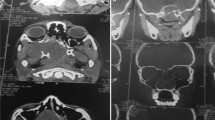Abstract
This study is a retrospective analysis of 30 consecutive cases of Juvenile Nasopharyngeal Angiofibroma (JXA) operated at. Department of Head and Neck Surgery, Kidwai Memorial Institute of Oncology Bangalore, India: la tertiary referral centre) after prior emohilization by an interventional neuro-radiologisl (1996-2002). This study discusses critically the planning of surgical approach, based on anatomico-radiological factors and highlights the efficacy of preoperalive embolization in expediting total re moral of the tumor in 25 out of JO cases with advanced stage JNA.
Objectives: To analyze the utility of pre-operatire embolisation in surgical extirpation of large JNAs; planning of the surgical approaches based on CT topography of the tumor; to study the various complications of embolisation and surgery associated with JXA & lastly to evaluate the puttern and location of recurrent tumor thus correlating with the original topography.
Setting: Tertiary care cancer referral centre.
Patients: Patients ranged in age from ’)- 24 years. all being males.
Interventions: Majority of them were accessed by transfacial surgical approach(26). and in the recent past via midfacial degloving(4) within 4H hours of angioembolisation.
Results: Complete removal of the tumor was achieved in 25 out of 30 cases with advanced stage JNA.
Post surgical CT scans revealed tumor residua in 5 individuals, where the tumor was documented in - the temporal fossa 12), para-cavernous sinus region (I), cavernous sinus! I) and pterygo palatine fossa (I). Only the lesion in pterygopalaline fossa was successfully re-i>xcised & this alongwith the recurrence at para-cavernous & cavernous sinus & another were treated with radiotherapy; the 2 cases in the temporal fossa are under observation. The average blood loss during the procedure was 546.60 ml.
Conclusions: Today, advances in radiologie imaging-complemented by interventional neuro-radiological expertise in angio-embolisation have expedited complète excision with minimal morbidity and acceptable recurrence rate. This study has justified pre-operative embolisation and M currently the standard of care for advanced JXA.
Similar content being viewed by others
References
Lee. J.R., Qian. J., Shan X. Z., Wang L. Evaluation of the effectiveness of preoperative embolisation in surgery for nasopharyngeal angiofibroma. European Archives of Otorhinolaryngology(1998); 255 (8) - 430.
Fagan J.J., Snyderman C.H., Carrau R.L., Janecka.I.P. Nasopharyngeal angiofibroma: selecting a surgical approach. Head and Neck (1997); Aug 19(5) - 391–9.
Mitskavich M.T., Carrau R.L., Synderman C,H., Weissman J.L., Fagan J.J. Intranasal endoscopic excision of a juvenile angiofibroma. Auris Nasus Larynx (1998); Jan 25 (1)- 39–44.
Arne W.Scholtz, Elisabeth Appenroth, Keren Kammen -Jolly, Lars U. Scholtz.Walter F.Thumfart. Juvenile Nasopharyngeal Angiofibroma:Management and Therapy.Laryngoscope (2001); April (4) - 681–687.
Gupta. A.C., Murthy. D.P. Intracranial juvenile nasopharyngeal angiofibroma. Aust N Z journal of Surgery (1997); Jul 67(7) - 477–82.
David J Howard, Glyn Llyod, Valerie Lund. Recurrence and Its Avoidance in Juvenile Angiofibroma. Laryngoscope (2001); Sep. 111(9) - 1509–1511.
George A. Gates, Dale H. Rice, Charles F. Koopmann, Jr., David E. Schuller. Flutamide- Induced Regression of Angiofibroma. Laryngoscope (1992); June (102) - 641-644.
Kasper M.E., Parsons J.T., Mancuso A.A. et al. Radiation therapy for juvenile angiofibroma: evaluation by CT and MRI analysis of tumor regression, and selection of patients. International Journal of Radiation Oncology and Biol. Physics (1993); (25) - 689–694.
Herman. P., Lot. G, Chapot. R., Huy. P.T. Long term follow up of juvenile nasopharyngeal angiofibromas: analysis of recurrences. Laryngoscope (1999); Jan 109 (1) - 140–147.
Radkowski D., McGill T., Healy G. B. Ohlms L., Jones D. T. Angiofibroma - Changes in Staging and treatment. Archives of Otolaryngology Head and Neck Surgery (1996) Feb 122 (2) - 122–129.
De Vincentiis, M., Gallo. A., Minni. N., Torri. E., Delia Rocca. C. Preoperative embolization in the treatment protocol for rhinopharyngeal angiofibroma: comparison of the effectiveness of various materials. Acta Otorhinolaryngology Italy (1997) Jun 17 (3) - 225–32.
Author information
Authors and Affiliations
Rights and permissions
About this article
Cite this article
Shenoy, A.M., Grover, N., Janardhan, N. et al. Juvenile nasopharyngeal angiofibromas: A study of recurrence pattern and role of pre-Operative embolization - ‘a decade’S experience’. Indian J Otolaryngol Head Neck Surg 54, 274–279 (2002). https://doi.org/10.1007/BF02993742
Issue Date:
DOI: https://doi.org/10.1007/BF02993742




